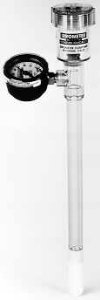Irrigation timing can be determined more precisely using a tensiometer. These water-filled tubes with a pressure gauge accurately reflect the amount of energy a plant needs to extract water from the soil. The pressure gauge measures tension values in centibar units (cbars). For citrus, when the gauge reads 30 centibars, it is a good time to irrigate. Tensiometers must be placed in the root zone between the emitter and the tree trunk. Having two tensiometers next to each other can be helpful in deciding when to turn the system on and off. For example, a tensiometer at a depth of 1 foot would indicate when to turn the water on, and a second at 3 feet would indicate when to turn the water off. Prevent tensiometers from being damaged during harvesting and other grove operations by placing a plastic milk crate or some other structure over each device.
Other devices can also be used to measure soil moisture. Gypsum blocks are very effective; the part in the ground is inexpensive but the reading device costs about $250, so a relatively large acreage is required to spread out the cost of the system. Portable meters rely on an electrical current carried by water in the soil. Even cheap $10 meters can give a rough estimate of the soil water content, but they are not very effective in rocky ground, because their sensitive tips break easily.
Soil-based methods monitor an aspect of soil moisture that, depending on the method, requires a correlation to plant water use. Some methods are well understood and inexpensive, others are expensive, inaccurate, inappropriate, or not well researched. Some methods allow multiple site readings, while others require a device to be left in place. Some measure soil water directly (e.g., oven-drying), and others measure another parameter, such as electrical conductance. Some methods are affected by salts or soil iron content, and others have limited value in the desired soil moisture range. Some, like tensiometers and gypsum blocks, give a reading from a porous material that comes to equilibrium with soil moisture, while many others use the soil directly as the measured medium—an important distinction, since discontinuities in the soil caused by rocks or gopher holes can affect readings. Also, some of the older techniques have been improved. For example, gravimetric oven-drying can now be done by microwave, considerably speeding up the process, and tensiometers and gypsum blocks can now be found with digital readouts and connections to data loggers that make data easier to manage. Many types of monitoring devices are available; the table below describes their characteristics.
As with any tool, the value of these devices increases with use and familiarity. Even though several are stationary devices, by placing them in representative positions in the grove, they can accurately reflect the entire grove. Some types of device can be stationary or portable, depending on the model.
|
Method |
Cost |
Ease of use |
Accuracy |
Reliability |
Salt-affected |
Stationary |
|
Gypsum block |
L |
H |
H |
H |
L |
YES |
|
Tensiometer |
L |
M |
H |
M |
L |
YES |
|
Portable tensiometer |
M |
M |
H |
M |
L |
NO |
|
Solid-state tensiometer |
M |
H |
H |
H |
L |
YES |
|
Time domain reflectometer |
H |
M |
H |
H |
M |
BOTH |
|
Neutron probe |
H |
L |
H |
H |
L |
YES |
|
Feel (soil probe) |
L |
H |
H |
H |
L |
NO |
|
Gravimetric (oven) |
L |
M |
H |
H |
L |
NO |
|
Conductance |
L |
H |
M |
M |
H |
BOTH |
|
Capacitance |
M |
H |
M |
H |
M |
BOTH |
H – high, M – medium, L - low
Attached Images:
